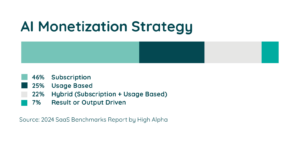
We Asked 7 Experts How to Save $1M on Software. Here’s What…
Table of Contents ToggleWhat Is Subscription-based Pricing?Characteristics of Subscription-based PricingAdvantages of...
Back
Back
Search for Keywords...
Blog

Table of Contents
The way SaaS (software-as-a-service) companies price their products and services plays a key role in how customers explore, adopt, and manage technology. Two popular models are subscription-based and usage-based pricing.
For example, of SaaS companies monetizing AI features, 25% employ usage-based pricing and 22% use a hybrid strategy combining both subscription- and usage-based models, showing that many vendors are exploring flexible pricing approaches.

Both approaches allow customers reliable access to the tools they need, but they differ quite a bit in structure, budgeting, implications, and overall value. It’s important for finance leaders, IT teams, and decision-makers to understand usage-based pricing vs subscription-based pricing.
Knowing the differences upfront helps organizations avoid wasted spend, negotiate contracts effectively, and ensure they select pricing that matches growth strategies.
Subscription-based pricing is a model where customers pay a fee for continued access to the product or service. This approach gradually became more common over the last decade, largely replacing one-time licensing fees. Customers typically choose from a range of tiers, each of which includes specific features, limits, and support levels.
Subscription-based pricing is designed to simplify billing and develop long-term customer relationships. Some key characteristics include:
This model offers stability and ease of management through:
Subscription pricing provides predictable billing for both vendors and customers. Businesses using this model can predict revenue with more accuracy, while customers can estimate their software expenses in advance. It also improves vendor-customer relations, since billing is a straightforward and ongoing process. In addition, subscription pricing presents access to updates as they emerge, as well as technical support to ensure the software remains current and effective.
Fixed costs can create inefficiencies and waste, like:
The biggest setback when it comes to subscription services is the potential for wasted spend. Customers pay for a fixed level of service regardless of how much they use it. This can result in over-licensing, where businesses pay for seats, features, or storage that they rarely or never end up using. It can also limit smaller businesses from scaling gradually, as they have to cover fixed costs upfront.
Another downside is subscription sprawl. Many organizations accumulate dozens of SaaS tools across departments, which makes it harder to track utilization and increases the risk of duplicate spending. Additionally, switching costs can be high if businesses want to leave a vendor mid-contract.
Managing fixed costs and utilization is a must.
Subscription-based pricing makes budgeting easier because decision-makers can predict steady costs ahead of time. That said, companies should then track license usage to prevent unproductive spending. IT and procurement teams may need to renegotiate contracts or adjust license counts to meet usage needs more effectively.
Subscription-based examples are widespread across collaboration, design, and CRM software. These services highlight how the model supports consistency and reliability in everyday business operations.
Usage-based pricing, which is also called “pay-as-you-go” pricing, is a model that charges customers based on how much they use the product or service. This approach has gained popularity in recent years, as many businesses prefer flexible and cost-effective solutions. Instead of flat, recurring fees, customers with usage-based plans only pay for what they actually use.
This pricing model is common among cloud platforms, APIs, and data services, where demand naturally fluctuates. Customers appreciate the ability to pay for exactly what they need instead of carrying unused capacity. Additional characteristics include:
This model offers flexibility and value-based spending.
Usage-based pricing allows businesses to align costs directly with service value. Companies that routinely use a product pay higher fees, while lighter users avoid overpaying for features they don’t use.
This option also lowers the barrier to entry for startups or small businesses that prefer not to lock into fixed costs. Vendors benefit from offering this model as well, being that usage-based pricing can lead to higher lifetime value as customers expand their usage over time.
Another major advantage is scalability. Companies can experiment, test, or run pilots without committing to long-term contracts, then seamlessly increase usage if adoption grows.
Uncertainty can make this model harder to manage due to:
A key challenge with usage-based pricing is its unpredictability. Because costs fluctuate as activity increases or decreases, finance teams may have a harder time forecasting budgets. Sudden growth or usage spikes can lead to higher bills. Vendors also have to contend with revenue uncertainty compared to the more stable subscription model.
Additionally, complex billing structures can create confusion for customers who struggle to map usage metrics (like compute hours or API calls) to business value. Some organizations may face billing surprises without strong monitoring systems.
Companies need to implement and use monitoring tools to track consumption closely. Finance and procurement teams should create guardrails, such as overage notifications, to prevent unexpected costs. Though this model allows for scaling, it also calls for ongoing management to ensure spending makes sense in terms of value.
Organizations often budget usage-based spend in variable ranges instead of fixed amounts, treating it like a utility bill. Building buffer funds into budgets can help reduce the shock of spikes. Vendor dashboards and SaaS spend management platforms can also provide real-time visibility.
“Managing usage-based pricing can be complex: 51.7% of IT leaders find software licensing models difficult to manage, and 65% report unexpected charges due to consumption-based or AI pricing models. This makes monitoring and forecasting critical for organizations adopting usage-based plans.”
Usage-based pricing performs well in infrastructure, communications, and analytics, where usage is inherently variable.
To make it easier to understand the key differences between subscription-based and usage-based pricing, the table below highlights how each model impacts cost structure, predictability, scalability, and budgeting.
The right choice depends on your organization’s needs and risk tolerance.
Choosing between pay-per-use vs subscription depends on several factors, including your organization’s priorities, growth stage, and consumption patterns. Companies with predictable usage and established teams tend to benefit from subscription pricing, while businesses with variable or fast-scaling needs may prefer the flexibility of usage-based pricing.
Another key decision point is risk tolerance. Companies that value cost certainty often lean toward subscriptions, while those more comfortable with variability in exchange for flexibility benefit more from usage-based pricing.
Looking ahead, by 2027, 70% of the top 20 SaaS vendors by revenue are expected to offer consumption-based pricing for part of their portfolios, indicating a shift toward more flexible models.
This approach fits best where workloads and demand shift frequently. It’s especially useful in development-heavy organizations that scale resources up and down quickly.
Subscriptions excel in large organizations where cost stability is incredibly important. Predictable pricing makes financial planning easier across multiple departments.
Regardless of the pricing structure you’re given, what matters is making sure your spending reflects the value received. Without transparency, it’s easy to overspend on unused subscriptions or face surprise bills with usage-based contracts.
The reality is that most organizations will use a mix of both models. By comparing costs across both models, companies can make informed decisions that balance flexibility and predictability.
A SaaS Management Platform like Zylo helps businesses monitor software usage, analyze spend, and ensure every dollar delivers measurable results. It provides visibility and governance, ensuring your company only pays for the software it truly uses and needs.
Schedule a demo with Zylo today and gain full visibility into your SaaS usage and costs.

Table of Contents ToggleWhat Is Subscription-based Pricing?Characteristics of Subscription-based PricingAdvantages of...

Table of Contents ToggleWhat Is Subscription-based Pricing?Characteristics of Subscription-based PricingAdvantages of...

Table of Contents ToggleWhat Is Subscription-based Pricing?Characteristics of Subscription-based PricingAdvantages of...

Table of Contents ToggleWhat Is Subscription-based Pricing?Characteristics of Subscription-based PricingAdvantages of...
| Cookie | Duration | Description |
|---|---|---|
| cookielawinfo-checkbox-analytics | 11 months | This cookie is set by GDPR Cookie Consent plugin. The cookie is used to store the user consent for the cookies in the category "Analytics". |
| cookielawinfo-checkbox-functional | 11 months | The cookie is set by GDPR cookie consent to record the user consent for the cookies in the category "Functional". |
| cookielawinfo-checkbox-necessary | 11 months | This cookie is set by GDPR Cookie Consent plugin. The cookies is used to store the user consent for the cookies in the category "Necessary". |
| cookielawinfo-checkbox-others | 11 months | This cookie is set by GDPR Cookie Consent plugin. The cookie is used to store the user consent for the cookies in the category "Other. |
| cookielawinfo-checkbox-performance | 11 months | This cookie is set by GDPR Cookie Consent plugin. The cookie is used to store the user consent for the cookies in the category "Performance". |
| viewed_cookie_policy | 11 months | The cookie is set by the GDPR Cookie Consent plugin and is used to store whether or not user has consented to the use of cookies. It does not store any personal data. |
